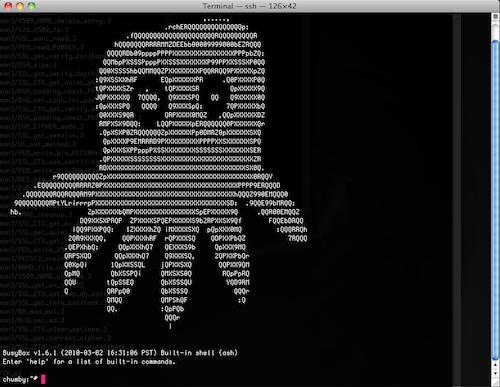Posted by md
on September 11, 2010

Faxes are an rather old method for communication, but in Germany they have one advantage: as opposed to emails, faxes are legally binding in the same way as letters are. So, from time to time, sending out a fax is useful. In addition, I have a telephone flatrate included in my data plan, so I don’t have to pay the postage for letters any more. The plan: use the USB port on my router to attach a modem and send out faxes using the mgetty package.
For 3 Euro I acquired an old ELSA Microlink 56k USB modem. I did some research, this modem is one of the few ones supported by the Linux usb-cdc kernel drivers. In addition it can be powered from USB only, so I don’t need another power supply. A week after winning an auction on ebay it arrived today.
My router runs OpenWRT. I installed the following packages using the opkg system:
kmod-usb2
kmod-usb-uhci
kmod-usb-net
kmod-usb-core
kmod-usb-acm
mgetty
mgetty contains a program called “sendfax”, which can be used to dial a number and send the data. The latter needs to be in G3 format. Since I write all my letters using LaTeX, I integrated a “fax” target into my Makefile for LaTeX documents. This target reads the PDF output of LaTeX and converts it to G3 using Ghostscript. The essential command is:
gs -dSAFER -dBATCH -dNOPAUSE -sDEVICE=dfaxhigh -sOutputFile=fax.g3.%d -q main.pdf
This creates a bunch of fax.g3.* files, one for each page within the PDF file. Then, I simply copy these files to my router and issue the sendfax command, for example:
sendfax #fax number# fax.g3.1 fax.g3.2
The command dials the fax number and sends the specified g3 files:
root@nibbler:~# sendfax 032121xyzxyz fax.g3.1 fax.g3.2
Trying fax device '/dev/ttyACM0'... OK.
Dialing 032121xyzxyz... OK.
sending 'fax.g3.1'...
sending 'fax.g3.2'...
If an error occurs, the command will fail and tell you about it. The mgetty package also contains various scripts for building a fax spooler, but for my personal usage, I will stick to raw sendfax. Please note that it is also possible to receive faxes, but I did not install these components so far.
No more postage for me. Yay!
Picture: CC-BY-SA-NC vtengr4047, thanks!
Posted by md
on July 30, 2010
At the moment I am building a small demo based on the AVR Raven and Contiki. I was running into some trouble with building the Firmwares on my Mac – this is the documentation of the workarounds.
The Contiki build system depends on some GNU utilities that are not installed. Using the following steps I was able to compile for the “native” (i.a. Mac OS) target:
- Install GNU binutils using MacPorts.
- Edit “cpu/native/Makefile.native” and adjust the “Compiler Definitions” section like this:
### Compiler definitions
CC = gcc
LD = gcc
AS = as
NM = nm
# Use GNU ar instead of /usr/bin/ar
AR = gar
OBJCOPY = objcopy
STRIP = strip
ifdef WERROR
CFLAGSWERROR=-Werror -pedantic -std=c99 -Werror
endif
CFLAGSNO = -Wall -g -I/usr/local/include $(CFLAGSWERROR)
CFLAGS += $(CFLAGSNO) -D_XOPEN_SOURCE=500 -O
# Simplify ld arguments
#LDFLAGS = -Wl,-Map=contiki-$(TARGET).map,-export-dynamic
LDFLAGS = -Wl
Another issue is the ELF binaries for the AVR Raven boards. These files contain all components of the programs: flash and eeprom
images as well as fuse settings. Unfortunately, avrdude cannot read the ELF format. So you have to extract the flash manually:
$ avr-objcopy -R .eeprom -R .fuse -R .signature -O ihex $NAME.elf $NAME.hex
It works similar for the EEPROM section (where the IP data is stored):
$ avr-objcopy -j .eeprom --set-section-flags=.eeprom="alloc,load" --change-section-lma .eeprom=0 -O ihex webserver6.elf webserver6.eep
You can also check which fuse settings are used:
$ avr-objdump -d -S -j .fuse webserver6.elf
webserver6.elf: file format elf32-avr
Disassembly of section .fuse:
00820000 <__fuse>:
820000: e2 99 ff
The directory structure of Contiki is somewhat overwhelming. I am currently working in these directories:
- contiki-2.4/platform/avr-ravenlcd: This is where the code for the ATMega3290p lives. Run make here and upload.
- contiki-2.4/platform/avr-raven: The ATMega1284p code lives here, this is where most patches are. Don’t run make here!
- contiki-2.4/examples/webserver-ipv6-raven: Run make here for the ATMega1284p code. This builds the webserver code and includes the platform/avr-raven dir.
In addition, I have a serial terminal for debugging output:
screen -U /dev/cu.SLAB_USBtoUART 57600
Posted by md
on June 02, 2010

It took me a while to figure this out, so here are my notes:
Continue reading…

